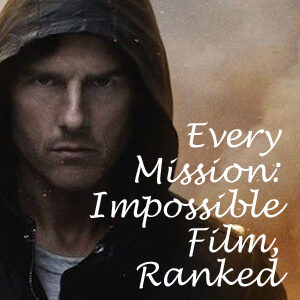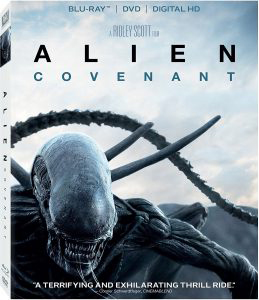Director and saga overseer Ridley Scott continues his process of linking “Prometheus” with “Alien” in the second of what’s supposed to be a “Prometheus” quadrilogy, “Alien: Covenant” (now available for rental and streaming).
While it’s at times derivative of other films in the series with its plot points and set pieces, it finds a balance between the Big Ideas of “Prometheus” (2012) and the straight-ahead horror of “Alien” (1979). This 11th film in the “Alien/Predator” franchise ranks somewhere in the middle of the pack, but that still makes it better than your average sci-fi film.
No expense spared
The most impressive things about “Covenant” are its set designs, locations and color palette. The titular ship – transporting 2,000 colonists in stasis — is colorful but muted; it feels like a place where people could live a long time if necessary.

“Alien: Covenant” (2017)
Director: Ridley Scott
Writers: Dan O’Bannon, Ronald Shusett, Jack Paglen
Stars: Michael Fassbender, Katherine Waterston, Billy Crudup
When the captain, Oram (Billy Crudup), opts to divert from their destination to explore a planet emitting a human transmission, the locale seems like a place where humans could settle. Shot in New South Wales, Australia, we see mountains and rivers and fields of wheat. Nearby is an ominous temple of the Engineers (the pale, oversized humans introduced in “Prometheus”), which features passageways and dens perfect for a hideous monster with a face that’s all teeth to sneak up on its next victim.
As we see in the opening flashback, android David (Michael Fassbender) and his creator, Peter Weyland (Guy Pearce), are the carryovers from “Prometheus.” (This explains why Pearce in old-age makeup was used in “Prometheus,” rather than an elderly actor.)
Some criticized that film – penned by “Lost’s” Damon Lindelof – for being too much of a head-scratcher, particularly in regard to David’s goals and alternating loyalties. “Covenant” is penned by John Logan and Dante Harper from a story by Jack Paglen and Michael Green; the latter did good work on this year’s “Logan,” but I’m not familiar with the other three. Although he’s not credited as a writer, I have to assume Scott is providing the overall narrative path so the saga holds together.
Another ragtag bunch
The characters leading the early 22nd century colonization mission are patterned after the concept from “Alien”: a ragtag bunch. Katherine Waterston (“Fantastic Beasts and Where to Find Them”) is Daniels, whose husband Branson (James Franco, for some reason) is the original captain who is killed in a horrific fire inside his cryo-pod.
She stands as the sympathetic audience surrogate, and clashes with Oram, who means well but overthinks things. He’s religious but tries to avoid being accused of using faith in his decision-making; a viewer gets the sense that the writers were trying for something deeper than what ends up on screen.

Danny McBride (“Eastbound and Down”) trades his goofiness for gruffness as pilot Tennessee, and Walter (Fassbender) is a Southern-accented model from the David series. The others are more or less xenomorph fodder, but collectively, they are an enjoyable batch to follow.
We’re now firmly in an era when special effects are so good they’re hardly worth commenting on, and such is the case with “Covenant,” where we get wonderfully horrific attack scenes featuring various incarnations of the disgusting embryonic xenomorphs. As the title and the trailer bluntly reveal, we then see the actual xenomorphs, and the ole facehugger and chestburster scenes haven’t lost their thrill, even if they aren’t necessarily shocking.
Themes and connections
Simply as a piece of entertainment, “Covenant” works, but fans of the saga will be interested in the themes and connections, so I’ll post a SPOILER WARNING here.
“Covenant” definitively reveals that David is the antagonist of the “Prometheus” saga, and he is a great villain, not only because of the creepily calm portrayal by Fassbender, but also because of the slow-burn manner in which Scott peels back the android’s thought process and actions. In the flashback prologue, David casually notes that God created humans, and humans created him, but he will live forever, whereas humans will not.
A miffed Weyland orders David to prepare his tea, and he follows his duty, but we get an inkling that David wants to use his long lifespan to create something, thus putting an ominous shroud on everything we saw in “Prometheus.”
Confirming our suspicions, we learn that in the 10 years since “Prometheus,” David used Dr. Elizabeth Shaw (Noomi Rapace) as a test subject on which to perfect his new species, and that he wiped out the planet’s Engineers with an instant plague. As we learned in “Prometheus,” the Engineers created humans, so things have now come full circle. (The word “covenant” means “contract” and “bond,” and I think we’re seeing a dark, inescapable connection between creators and their creations.)
But it’s not over yet: As she settles into cryosleep for the journey to the new colony planet at “Covenant’s” end, Daniels realizes the robot is not Walter but rather David. David tells Walter earlier in the film that humans are on their way out, as evidenced by the fact that they are desperately fleeing a dying Earth for colony planets. (By the time of “Alien Resurrection,” Earth is nearly uninhabitable.) However, David perhaps sees value in those 2,000 colonists as breeding stock.
Too many callbacks?
But as much as “Covenant” is a grand creation saga, it riffs on its predecessors a bit too much to stand out as a distinct entry, at least for the casual observer. Passengers being killed in their pods calls to mind the controversial opening of “Alien 3,” as does the fact that Daniels and Tennessee are at the mercy of David at the end of the film, similar to how Ripley, Hicks and Newt are at the mercy of a stowaway xenomorph.
The way our heroes close doors to shepherd the alien through the ship calls to mind “Alien 3’s” mining tunnels. The climactic scene where Daniels tries to blow the xenomorph out of a docking bay filled with heavy equipment will have “Aliens” popping into everyone’s head.
“Covenant” deserves credit for its less claustrophobic human vs. proto-xenomorph battles among the grass fields of the Engineers’ planet, as well as its coup de grace: Daniels shooting at an alien on the bridge of an open-air cargo hauler as Tennessee tries to steady it while a loose crane swings around. Your mileage may vary on whether this sequence is too blockbustery for this generally gritty franchise.
But certainly, we come out of “Covenant” with a less muddied picture of what’s going on, and what the major players’ goals are. The saga still needs to explain how xenomorphs exist BEFORE they are created by David, in the contemporary-set “Alien vs. Predator” films, plus the “Predator 2” cameo.
A time-travel twist a la “Planet of the Apes” springs to mind, but this is sci-fi, so there are plenty of possibilities. At any rate, Scott and company – barring box-office returns so low that the saga pulls a “Divergent” series and ends before the story is done – will have two more films to explain it.
Click here for John’s reviews of all the “Aliens” and “Predator” films.

